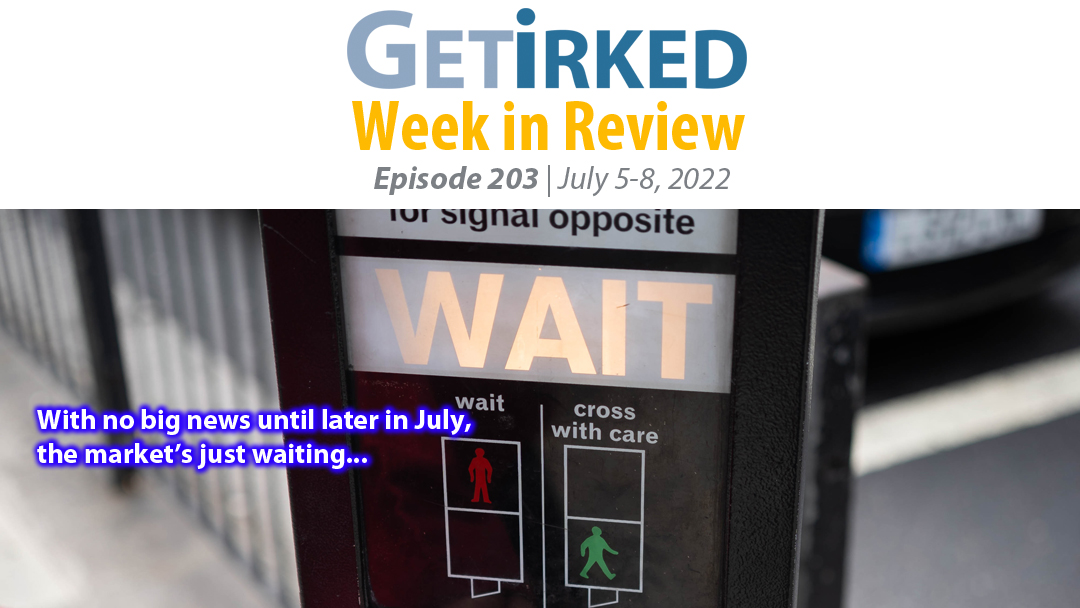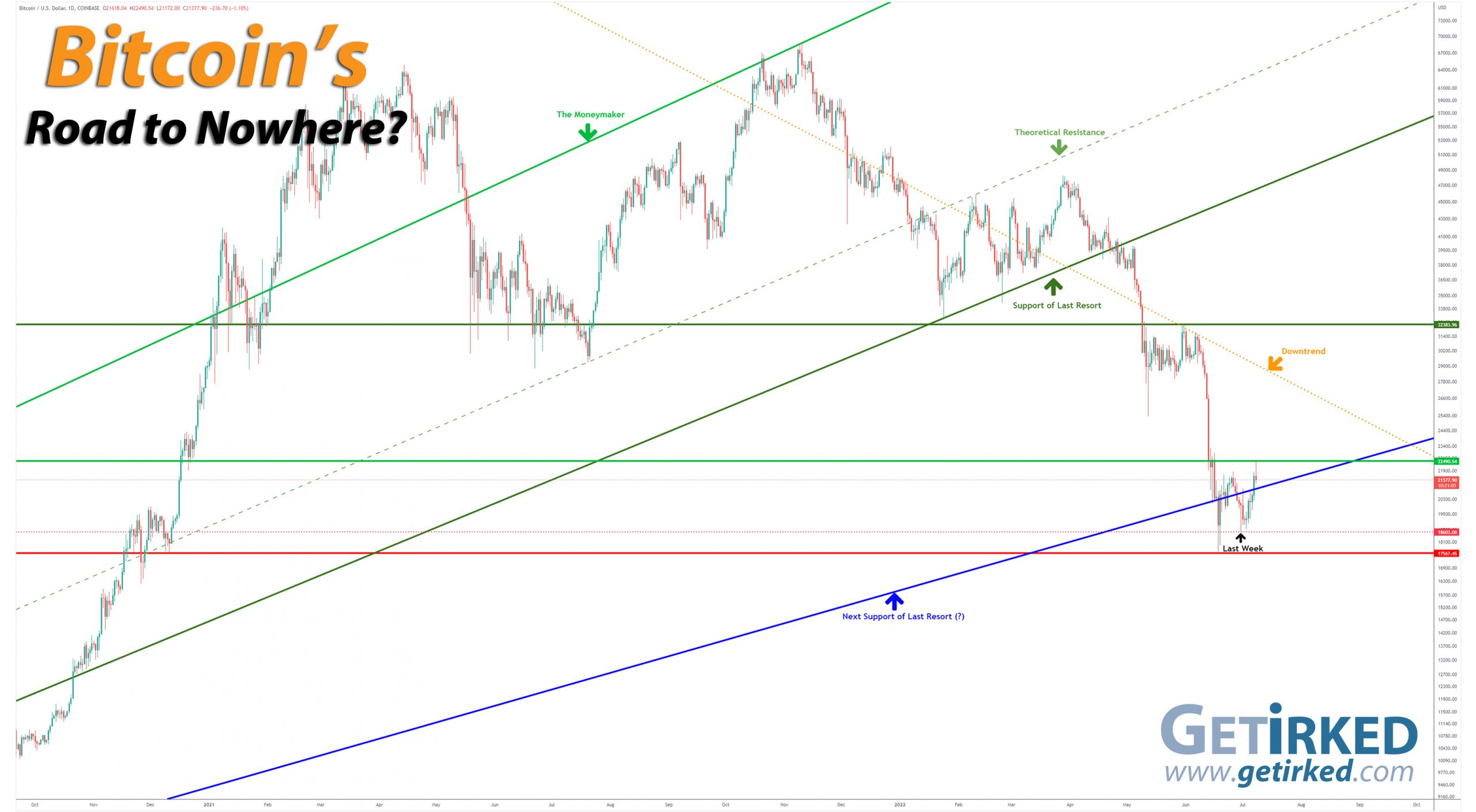Summing Up The Week
With the Fed meeting and earnings reports not starting later in July, the market was reacting to every small news event and trying to create news where there really wasn’t any, whether it was finding warning signs of recession in another inverted yield curve or reviewing the minutes from the Fed meeting last month.
The only truly “new” news this week was the jobs report on Friday which indicates the economy remains stronger than many feared.
Let’s take a look at the news that moved the markets this week…
Market News
Inverted yield curve warns of recession
On Tuesday, the curve on the 10-year Treasury yield and 2-year yield became inverted, meaning that the earned interest rate was actually higher for the shorter-term Treasury than the longer one, reported CNBC. Intuitively, it makes sense that you would only lend your money for a longer time period if you earned a higher rate of interest, so the interest-rate inversions often make news when they happen.
That, and a yield curve inversion is often correlated to an impending recession. “There’s something afoot in investor sentiment that is difficult to ignore, given the inversion is occurring with 10-year yields below 3%,” said Ian Lyngen, head of U.S. rates strategy at BMO. “I wouldn’t say it’s a direct indication that a recession is a near-term risk. Rather it’s consistent with increased concern about recession.”
The textbook definition of a recession is two or more back-to-back quarters of declining U.S. GDP growth, and seeing as how the Q1 of 2022 was already negative, many pundits believe we’ll see a negative Q2 which will indicate not a start of a recession, but, rather, that we’ve actually been in a recession since the beginning of the year.
Fed minutes reveal ‘more restrictive’ policy likely
On Wednesday, the minutes from the Federal Reserve’s June meeting showed that the central bank has every inclination to continue restricting financial policy should inflation stay high, reported CNBC.
“In discussing potential policy actions at upcoming meetings, participants continued to anticipate that ongoing increases in the target range for the federal funds rate would be appropriate to achieve the Committee’s objectives,” the minutes stated. “In particular, participants judged that an increase of 50 or 75 basis points would likely be appropriate at the next meeting.”
The Fed’s next two-day meeting happens later in July from July 26-27 where the central bank will hike rates once again. The question facing investors will be how big is the next hike – 50 basis points or 75?
Jobs stronger than expected with 372K new payrolls in June
On Friday, the Labor Department’s monthly payroll report showed nonfarm payrolls increased by 372,000 in June, significantly beating the 250,000 estimate, reported CNBC. As I’ve pointed out before, we’re in a Catch-22 when it comes to the jobs market – a strong jobs market indicates a strong economy, which is good, however, competition to get employees causes wage growth, which the Federal Reserve considers bad.
“The strong 372,000 gain in non-farm payrolls in June appears to make a mockery of claims the economy is heading into, let alone already in, a recession,” said Andrew Hunter, senior U.S. economist at Capital Economics. The wage number probably means Federal Reserve officials “are likely to press ahead with aggressive rate hikes over the coming months,” he added.
As a result, the markets sold off initially on Friday on the back of the payroll report.
Next Week’s Gameplan
With the U.S. economy in flux and geopolitical concerns still raging throughout the globe, we can expect that market volatility will continue, particularly when looking at the seasonality issues of low trading volume due to traders and investors taking vacations.
We can expect to continue to see a lot of whipsaw action as the world continues to navigate its way through this unknown economic climate. As always, plan in advance and keep your head on straight – don’t react emotionally. If you don’t know what to do, do nothing at all!
See you all next week!
This Week in Play
Stay tuned for this week’s episodes of my two portfolios Investments in Play and Speculation in Play coming online later this weekend!
Crytpo Corner
Important Disclaimer
Get Irked contributors are not professional advisers. Discussions of positions should not be taken as recommendations to buy or sell. All investments carry risk and all readers must accept their own risks. Get Irked recommends anyone interested in investing or trading any asset class consult with a professional investment adviser to determine if an investment idea is suitable to them and their investment goals.
Bitcoin Price (in USD)
%
Weekly Change
Bitcoin Price Action
The Big Bottom Debate continues…
Bitcoin broke through its previous post-crash high this week, setting a new high at $22,490.54 above the key Next Support of Last Resort (?) trendline we’ve been eyeing for weeks now. Over the past week, retained its weekly low from the week prior at $18,603.00.
From here, the next big move will be determined by what Bitcoin does next. Will it continue making new highs and push resistance higher into the $20Ks or will we see it retreat and test its weekly low at $18,603.00 or the 2022 low at $17,567.45? Time will tell.
The Bullish Case
Bulls strongly believe that the bottom is in with many pointing to historical data supporting a thesis that sentiment has never been so low in the space and that the space has not been as oversold in prior Crypto Winters as it has in 2022.
The Bearish Case
Bears point to Bitcoin’s historical tendency to, well, ignore historical tendencies. One of the biggest pitfalls to both Bulls and Bears in crypto is to believe that Bitcoin won’t head higher or go lower because it hasn’t done so, historically. Of course, Bitcoin will then surprise by doing that which it hasn’t before.
Up until its current selloff, Bitcoin had never sold off lower than a previous bull rally’s high. Since 2017’s high was right at $20,000, Bitcoin should have held that level. When Bitcoin broke through it significantly, that means we’re in No Man’s Land.
For me, it means that the Bears have the upper hand in the current trend. While some Bears are predicting no bottom until the 2018 low around $3130, I believe a pullback to the $10K-$14K is more likely to provide bottoming support.
Bitcoin Trade Update
Current Allocation: 16.026% (Unchanged since last update)
Current Per-Coin Price: $23,780.95 (Unchanged since last update)
Current Profit/Loss Status: -10.173% (+8.842% since last update)
With Bitcoin still trading in a range over the past week, not testing the lows from the week prior and not breaking through my per-coin price, this was another of those “sit on your hands” weeks where I just wait and plan.
Given that the overall macro-trend is still very bearish, I’m in no hurry to add above $19K, where I made my last small buy, so I will wait patiently to see what Bitcoin does next before I make my next move.
Bitcoin Buying Targets
Using Moving Averages and supporting trend-lines as guides, here is my plan for my next ten (10) buying quantities and prices:
0.204% @ $18,789
0.204% @ $18,306
0.204% @ $17,975
0.408% @ $17,636
1.224% @ $16,270
1.633% @ $15,387
3.265% @ $14,407
3.265% @ $12,109
4.898% @ $10,736
3.265% @ $9,481
No price target is unrealistic in the cryptocurrency space – Bullish or Bearish.
While traditional stock market investors and traders may think the price targets in the cryptocurrency space are outlandish due to the incredible spread (possible moves include drops of -90% or more and gains of +1000% or more), Bitcoin has demonstrated that, more than any speculative asset, its price is capable of doing anything.
Here are some of Bitcoin’s price movements over the past couple of years:
- In 2017, Bitcoin rose +2,707% from its January low of $734.64 to make an all-time high of $19,891.99 in December.
- Then, Bitcoin crashed nearly -85% from its high to a December 2018 low of $3128.89.
- In the first half of 2019, Bitcoin rallied +343% to $13,868.44.
- In December 2019, Bitcoin crashed -54% to a low of $6430.00 in December 2019.
- In February 2020, Bitcoin rallied +64% to $10,522.51.
- In March 2020, Bitcoin crashed nearly -63% to a low of $3858.00, mostly in 24 hours.
- Then, Bitcoin rallied +988% to a new all-time high of $41,986.37 in January 2021.
- Later in January, Bitcoin dropped -32% to a low of $28,732.00.
- In February 2021, Bitcoin rallied +103% to a new all-time high of $58,367.00.
- Later in February, Bitcoin dropped -26% to a low of $43,016.00.
- In April 2021, Bitcoin rallied +51% to a new all-time high of $64,896.75.
- In June 2021, Bitcoin crashed -56% to a low of $28,800.00.
- In November 2021, Bitcoin rallied +140% to a new all-time high of $69,000.00.
- In June 2022, Bitcoin crashed -75% to a low of $17,567.45.
Where will Bitcoin go from here? Truly, anything is possible…
What if Bitcoin’s headed to zero?
The only reason I speculate in the cryptocurrency space is I truly believe Bitcoin isn’t headed to zero. I am prepared for that possibility, however, by knowing I could potentially lose all of the capital I’ve allocated to this speculative investment. Professional advisers recommend speculating with no more than 5% of an investor’s overall assets. Personally, I’ve allocated less than that to speculating in crypto. I feel that anyone who doesn’t fully believe in the long-term viability of cryptocurrency would be better served not speculating in the space. On a good day, this asset class isn’t suitable for those with weak stomachs. On volatile days, the sector can induce nausea in the most iron-willed speculator. If a speculator isn’t confident in the space, the moves will cause mistakes to be made.


